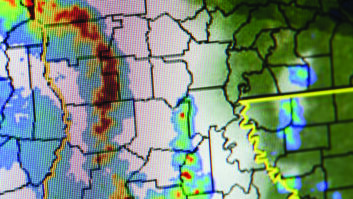The broadcast technical community is chattering about Friday’s incident in which a nationally syndicated radio show inadvertently transmitted audio tones and triggered an Emergency Alert Notification (EAN) message that was shared with radio and television audiences across parts of the United States.
The glitch occurred during the airing of the “Bobby Bones Show,” which originates from the studios of WSIX(FM) in Nashville, Tenn., and is syndicated by Premiere Networks, part of iHeartMedia. The morning show is heard on some 100 radio stations, most of them with country music formats.
Members of the alerting community have been discussing it on listservs such as the EAS group maintained by the Society of Broadcast Engineers.
“It’s a big mess,” Gary Kline, senior VP of engineering and Broadcast IT for Cumulus Media, told Radio World. Beyond the immediate concern over a false alert, he said, is the problem that this could happen at all, “that a station (not the president or his designee) could trigger an EAN alert. Scary stuff. I know there are a lot of people working hard to make sure something like this doesn’t happen again.”
The alert message as received on some television screens stated in part, “The station has interrupted its regular programming at the request of the White House to participate in the Emergency Alert System.” According to media reports the alerts was viewed in Michigan, Georgia, North Carolina, Arkansas, Tennessee, Texas and others.
The Federal Emergency Management Administration, which is responsible for the initial transmission of presidential alerts, responded with this statement: “On Friday there was an inappropriate playing of the national emergency alert notification tones on a syndicated radio broadcast. There is not a national emergency. FEMA will be working with the FCC and EAS device manufacturers to identify improvements to the message validation schemes for EAS. While changes take some time to implement, there are some things you can do to help prevent inappropriate alerts from being propagated.”
FEMA advises broadcasters to configure all EAS devices to not forward an EAS message with a header that does not match the current date and time. (See its full statement at bottom.)
The audio tone and resulting erroneous EAN caused alarm among the emergency alerting community, which has been watching closely as FEMA and the Federal Communications Commission work to improve EAS and solve lingering operational and security issues.
As the investigation into the incident continues, broadcast industry reaction was swift. Tennessee Association of Broadcasters President Whit Adamson said in a Friday statement, “It’s a momentary glitch or accident that we hope doesn’t happen again.”
Below is the text of the official statement Friday from the FEMA Integrated Public Alert and Warning System:
On Friday there was an inappropriate playing of the national emergency alert notification tones on a syndicated radio broadcast. There is not a national emergency. Today’s broadcast triggered alert notification in states where the alert has been played. Certain alerts, like the one broadcast today, are designed to be automatically picked up and rebroadcasted by other radio and TV stations.
FEMA will be working with the FCC and EAS device manufacturers to identify improvements to the message validation schemes for EAS. While changes take some time to implement, there are some things you can do to help prevent inappropriate alerts from being propagated.
Short Term:
-If possible, configure your EAS device to NOT FORWARD an EAS message with a header that does not match the current date and time, i.e. configure to “enforce strict time”
-Socialize the implications of including EAS tones in the broadcast (§11.45 “Prohibition of false or deceptive EAS transmissions”) among the content providers and program directors
-Learn how to clear a “locked up” EAS device
-Check your EAS device software version and ensure you are up to date with new patches
-Use strong passwords for any broadcast equipment that is accessible from the web
-Use firewalls to prevent unauthorized web-access to broadcast equipment
Long Term:
-Continuously monitor information from FEMA, FCC, and EAS device manufacturers regarding EAS security












